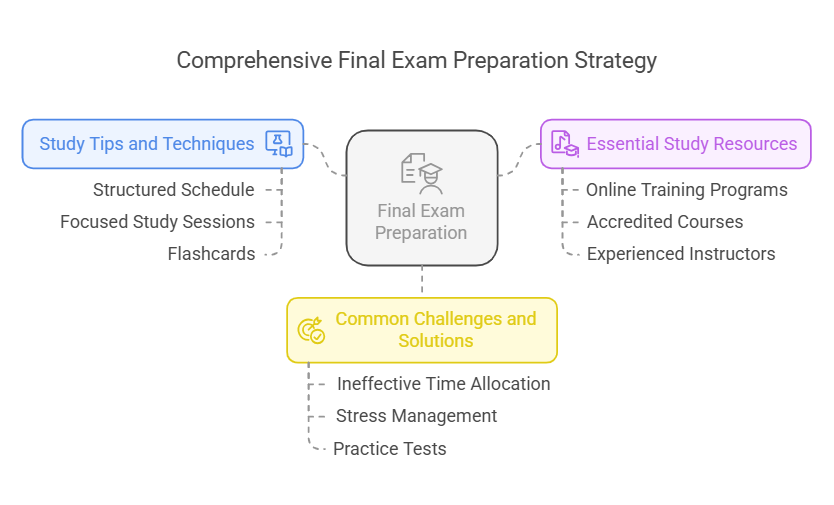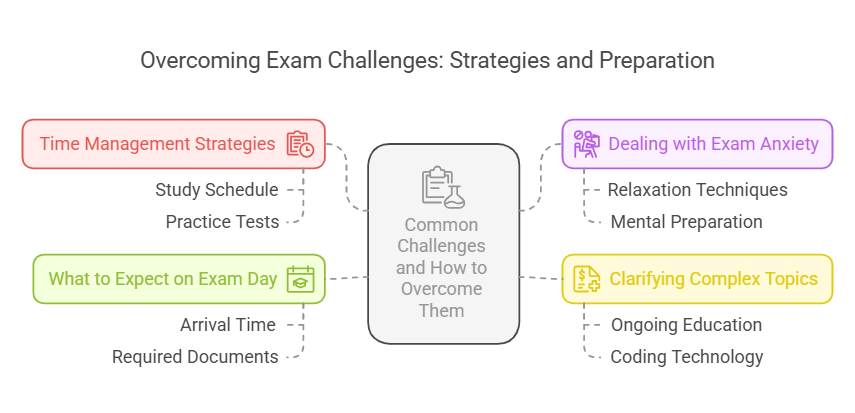Crack the Professional Medical Coding and Billing Final Exam: Tips and Strategies
Preparing for the Professional Medical Coding and Billing exam can be a challenging process, but with the right strategies, you can increase your chances of success. This guide will walk you through the exam structure, key topics, and provide effective preparation tips to help you achieve a passing score.

Key Takeaways for Success in Medical Coding and Billing Certification
The Professional Medical Coding and Billing Final Exam consists of 100 multiple-choice questions designed to assess your knowledge of medical terminology, coding guidelines, and practical coding applications. A passing score of 70% is required to succeed. To prepare for the exam, structured study plans, utilizing essential resources like online courses, and continuous education to stay updated with industry standards, such as medical billing and coding certification from AMBCI, are highly recommended. On the day of the exam, make sure to arrive early with the required identification, use effective time management strategies, and practice relaxation techniques to help maintain focus throughout the exam.
Understanding the Professional Medical Coding and Billing Final Exam
The Professional Medical Coding and Billing Final Exam tests your knowledge of both medical coding and billing techniques through a set of 100 multiple-choice questions. This exam will evaluate your understanding of essential concepts such as medical terminology, the principles of coding, and specific coding systems like CPT, ICD-10-CM, and HCPCS Level II. You have four hours to complete the exam, and achieving a score of 70% or higher is necessary to pass.
Exam Structure and Format
The exam consists of 100 multiple-choice questions, and it is divided into key subject areas such as anatomy, medical coding principles, and coding systems like CPT, ICD-10-CM, and HCPCS Level II. You will also need to demonstrate proficiency in translating patient documentation into accurate codes. You have four hours to finish the exam, and achieving a minimum passing score of 70% is required to pass.
Key Areas Covered in the Exam
The exam covers various important aspects of medical billing and coding. One of the most critical areas is a solid understanding of medical terminology, which is necessary to decode patient records and accurately encode diagnostic information. A thorough knowledge of official coding guidelines is also essential to ensure compliance with healthcare regulations and to maintain accuracy in billing practices. The exam also focuses on translating patient documentation into precise codes, which are vital for reimbursement processes.

Preparing for the Final Exam
To succeed in the exam, you need to engage in thorough preparation. This includes using various study methods, key materials, and practical exercises. Many students face challenges such as complex coding concepts, time management issues, and exam anxiety. A comprehensive approach to preparation that includes study time, application exercises, and stress management techniques is vital.
Study Tips and Techniques
One of the best ways to improve retention and understanding is through a structured study schedule. Break down your study sessions into short, focused blocks followed by breaks to avoid burnout. Flashcards are an effective tool for reinforcing medical terminology and anatomy concepts. Smaller, focused study sessions can enhance concentration and productivity.
Essential Study Resources
Online training programs provide flexible, comprehensive education tailored for medical coding certification. Accredited medical coding courses cover essential topics such as medical terminology, anatomy, coding guidelines, and code sets like CPT, ICD-10-CM, and HCPCS Level II. Experienced instructors can also provide valuable insights into complex medical coding concepts.

Common Challenges and How to Overcome Them
During the preparation process, students often encounter challenges such as ineffective time allocation and stress. A well-organized study schedule can help you prioritize tasks and reduce distractions. Practice tests can also help identify areas of weakness, allowing you to focus your study efforts more effectively.
Time Management Strategies
Managing your study time efficiently is key. Focus more time on areas where you feel less confident and use practice tests to gauge your progress. During the actual exam, managing your time effectively is crucial. Aim to allocate about two minutes per question to ensure you have enough time to answer all questions.
Dealing with Exam Anxiety
Relaxation techniques such as deep breathing can help manage anxiety before and during the exam. Visualization and taking short breaks can also reduce stress and improve focus during the exam. Staying hydrated and getting enough rest before the exam are also important for maintaining mental clarity.
Clarifying Complex Topics
Navigating medical coding requires understanding detailed terminologies and complex diagnosis codes. If you find medical records ambiguous, it’s important to develop the skills to interpret them accurately. Ongoing education and the use of coding technology can help you stay updated on evolving coding guidelines and improve your accuracy.
What to Expect on Exam Day
On the day of the exam, make sure you arrive at least 30 minutes before the scheduled time. Bring a valid government-issued photo ID, as temporary or digital IDs will not be accepted. A little preparation and organization will help reduce any stress you may feel.

Test-Taking Strategies
Allocating two minutes per question is an effective time management strategy. Practice tests under timed conditions will help you become more familiar with the test format and improve your ability to manage time effectively during the actual exam.
Staying Calm and Focused
Make sure you get enough rest the night before the exam to ensure you're mentally sharp. Taking short breaks during the exam can help you maintain focus and stay calm.
Post-Exam Steps
Once you have completed the exam, you will receive your results through email or an online portal. If you pass, your certification will be mailed to you.
Medical Coding Certification and Career Opportunities
Once certified, medical coders can find employment in various healthcare settings, including hospitals, outpatient clinics, and insurance companies. There are also opportunities in telehealth services and other emerging healthcare platforms. Certification can significantly boost your career prospects and earning potential.
Continuing Education and Advanced Certifications
To maintain your certification, you will need to complete continuing education credits annually. Pursuing advanced certifications like Certified Professional Coder (CPC) and Certified Professional Biller (CPB) can further enhance your career opportunities and professional reputation.
Summary
Successfully passing the Professional Medical Coding and Billing Exam requires a deep understanding of the exam’s structure, strategic preparation, and the ability to overcome challenges. With the right approach, you can confidently pursue your certification and enjoy the many career opportunities that come with it.
6 Less-Known Facts:
ICD-10-CM Code Set Size: The ICD-10-CM code set is extensive, encompassing a vast number of codes to cover a wide range of diseases and conditions.
CDCDemand for Medical Coders: According to the U.S. Bureau of Labor Statistics, employment of health information technologists and medical registrars is projected to grow 16% from 2023 to 2033, much faster than the average for all occupations.
Bureau of Labor StatisticsSpecial Codes for Rare Diseases: The ICD-10-CM code set includes specific codes for rare diseases and conditions, highlighting the importance of accurate coding for proper reimbursement.
CDCCPC and CPB Certifications: Certifications like Certified Professional Coder (CPC) and Certified Professional Biller (CPB) can be pursued online, offering flexibility for working professionals.
AAPCSpecialization in Medical Coding: Medical coders have the option to specialize in areas such as anesthesia or radiology, each requiring specific coding knowledge.
CDCAnnual CPT Code Updates: The CPT code set is updated annually, making it essential for professionals to stay current with changes to ensure accurate coding.
CDC
FAQs:
-
The program includes an AAPC exam voucher, which provides students with a savings of up to $399.
-
The program offers flexible payment plans, starting at $189 per month, allowing students to choose the best option for their financial needs.
-
The program is taught by experienced instructors with decades of experience in coding and billing, ensuring high-quality education.
-
The program can be completed in just 8 weeks.
-
The program offers dual certifications: Certified Professional Coder (CPC) and Certified Professional Biller (CPB).
